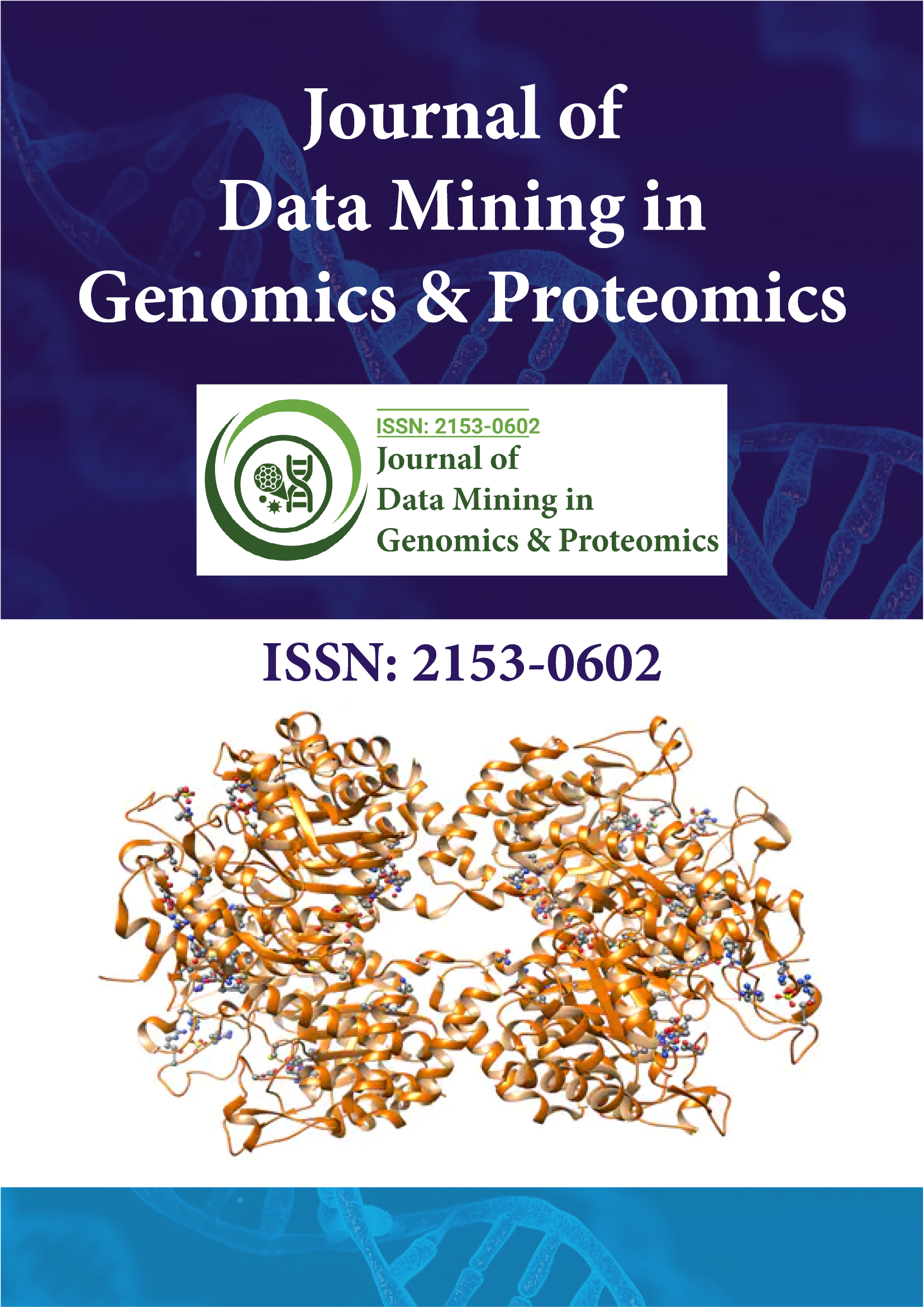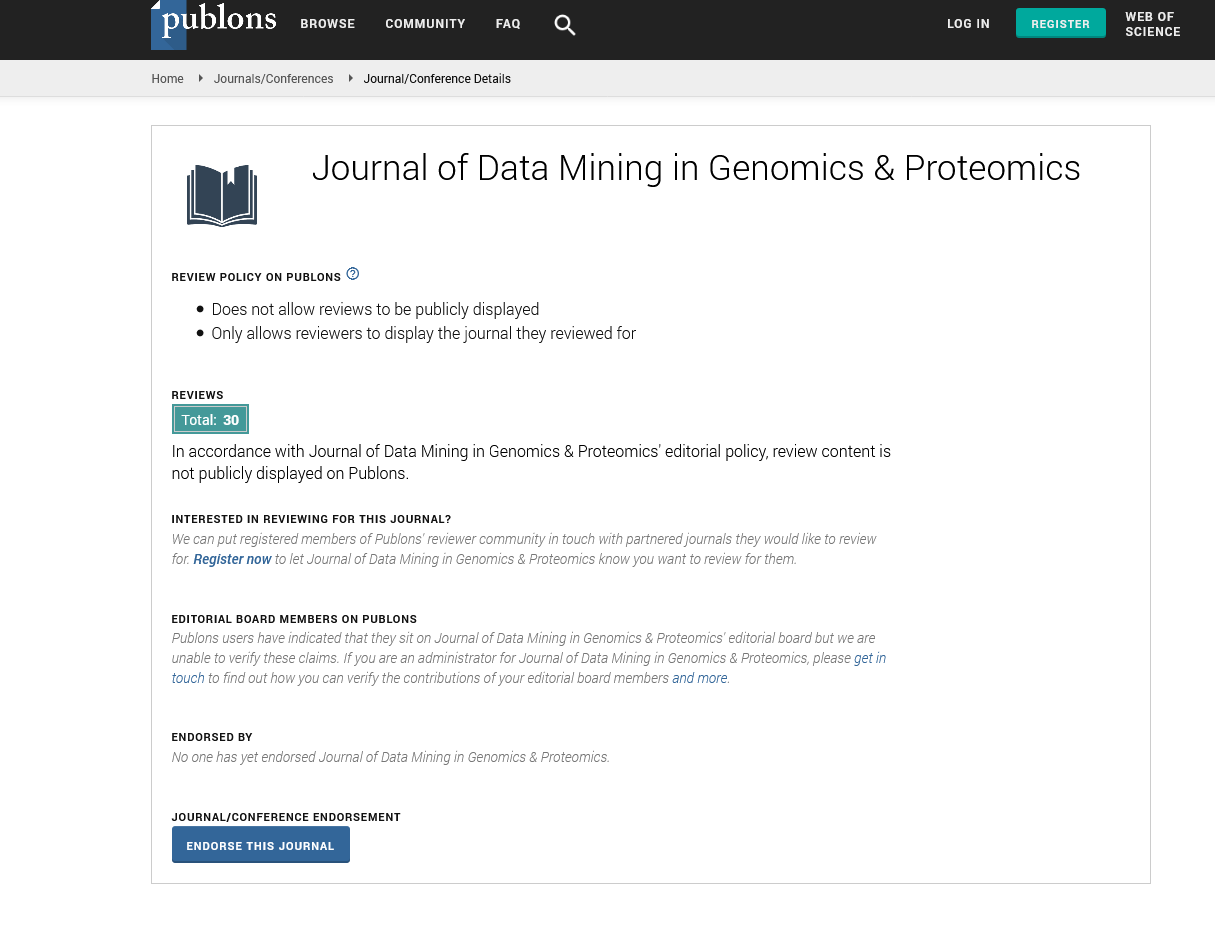Indexed In
- Academic Journals Database
- Open J Gate
- Genamics JournalSeek
- JournalTOCs
- ResearchBible
- Ulrich's Periodicals Directory
- Electronic Journals Library
- RefSeek
- Hamdard University
- EBSCO A-Z
- OCLC- WorldCat
- Scholarsteer
- SWB online catalog
- Virtual Library of Biology (vifabio)
- Publons
- MIAR
- Geneva Foundation for Medical Education and Research
- Euro Pub
- Google Scholar
Useful Links
Share This Page
Journal Flyer

Open Access Journals
- Agri and Aquaculture
- Biochemistry
- Bioinformatics & Systems Biology
- Business & Management
- Chemistry
- Clinical Sciences
- Engineering
- Food & Nutrition
- General Science
- Genetics & Molecular Biology
- Immunology & Microbiology
- Medical Sciences
- Neuroscience & Psychology
- Nursing & Health Care
- Pharmaceutical Sciences
Short Communication - (2025) Volume 16, Issue 1
Deep Learning Approaches for Predicting Gene Expression Patterns in Cancer Genomes
Emily Johnson*Received: 24-Feb-2025, Manuscript No. JDMGP-25-29285; Editor assigned: 26-Feb-2025, Pre QC No. JDMGP-25-29285 (PQ); Reviewed: 12-Mar-2025, QC No. JDMGP-25-29285; Revised: 18-Mar-2025, Manuscript No. JDMGP-25-29285 (R); Published: 26-Mar-2025, DOI: 10.35248/2153-0602.25.16.377
Description
The explosive growth in genomic data, fueled by Next-Generation Sequencing (NGS) technologies, has revolutionized cancer research by providing unprecedented insights into the molecular underpinnings of tumor development, progression and therapeutic response. Among various molecular features, gene expression patterns are critical indicators of the functional state of a cell and its interaction with the tumor microenvironment. However, the complexity and high dimensionality of gene expression datasets, often with tens of thousands of genes and limited sample sizes, pose significant challenges in extracting meaningful patterns. In recent years, Deep Learning (DL), a subset of Artificial Intelligence (AI), has emerged as a powerful tool for modeling complex and nonlinear relationships within genomic data. This paper explores the application of deep learning techniques for predicting gene expression patterns in cancer genomes, highlighting their potential, challenges and future directions.
Gene expression prediction aims to infer the expression levels of genes from other molecular features, such as DNA sequences, epigenetic markers, or mutation data. Accurate prediction models not only enable a better understanding of gene regulatory networks but also offer practical advantages, such as imputing missing data, classifying cancer subtypes and identifying novel therapeutic targets. Traditional statistical and machine learning methods like linear regression, Support Vector Machines (SVM) and random forests have been widely applied in this domain. However, their limited capacity to model the intricate interactions in high-throughput biological data has driven the transition toward more sophisticated models like Deep Neural Networks (DNNs), Convolutional Neural Networks (CNNs) and Recurrent Neural Networks (RNNs).
Deep learning models are particularly suited for handling large-scale, multidimensional datasets due to their ability to learn hierarchical representations from raw input features. In the context of gene expression prediction, DNNs can be trained on multi-omics data, including genomic sequences, DNA methylation, histone modifications and chromatin accessibility. These models capture complex dependencies across biological layers, leading to more accurate and biologically meaningful predictions. For example, CNNs have been effectively used to analyze DNA sequences and learn motifs associated with gene regulation, while RNNs are well-suited for modeling temporal gene expression dynamics in time-series experiments.
A notable application of deep learning in this domain is the autoencoder, an unsupervised neural network architecture used for dimensionality reduction and feature extraction. Autoencoders learn compressed representations (latent features) of input data that preserve essential information, which can then be used to reconstruct gene expression profiles or predict phenotypic outcomes. For instance, Variational Auto Encoders (VAEs) have been used to integrate multi-omics data and identify latent factors associated with cancer progression and patient survival. Furthermore, Generative Adversarial Networks (GANs), another innovative DL framework, have been applied to synthesize gene expression data that closely mimics real biological profiles. This approach is particularly valuable in addressing the issue of limited sample sizes in cancer datasets, enabling data augmentation and improving the robustness of downstream predictive models.
Several large-scale cancer genomics consortia, such as The Cancer Genome Atlas (TCGA) and the International Cancer Genome Consortium (ICGC), provide high-quality datasets that are extensively used for training and validating deep learning models. These datasets offer paired genomic and transcriptomic profiles across various cancer types, facilitating the development of generalizable models capable of predicting expression across heterogeneous cancer contexts. In addition, publicly available repositories such as ENCODE and GEO contribute to the expanding training corpus, making it possible to build deep learning models that are both accurate and scalable.
Despite the promising results, the application of deep learning in predicting gene expression patterns comes with challenges. One of the major concerns is model interpretability. Deep learning models, particularly those with many layers and millions of parameters, are often regarded as "black boxes," making it difficult to understand the biological rationale behind their predictions. This lack of transparency hinders clinical adoption, especially in sensitive areas like cancer diagnosis and treatment planning. To address this, recent research has focused on interpretable DL models and explainability tools such as SHAP (SHapley Additive exPlanations) and attention mechanisms, which help identify key features contributing to model predictions.
Another limitation is the requirement for large training datasets. Deep learning models generally perform better with vast amounts of labeled data, which may not always be available in cancer studies, particularly for rare subtypes. Strategies such as transfer learning, where models pre-trained on large datasets are fine-tuned on smaller, specific datasets, and semi-supervised learning, which leverages both labeled and unlabeled data, are being actively explored to overcome this issue. Moreover, data heterogeneity poses a significant challenge. Gene expression is influenced by a variety of factors, including tissue type, tumor microenvironment, genetic variation and environmental conditions. Integrating these diverse factors into a single predictive framework requires robust normalization and preprocessing strategies, as well as domain knowledge to ensure biological validity.
References
- Housman G, Briscoe E, Gilad Y. Evolutionary insights into primate skeletal gene regulation using a comparative cell culture model. PLoS Genet. 2022;18(3):e1010073.
[Crossref] [Google Scholar] [PubMed]
- Grundberg E, Kwan T, Ge B, Lam KC, Koka V, Kindmark A, et al. Population genomics in a disease targeted primary cell model. Genome Res. 2009;19(11):1942-1952.
[Crossref] [Google Scholar] [PubMed]
- Breslin S, O'Driscoll L. The relevance of using 3D cell cultures, in addition to 2D monolayer cultures, when evaluating breast cancer drug sensitivity and resistance. Oncotarget. 2016;7(29):45745.
[Crossref] [Google Scholar] [PubMed]
- Chitcholtan K, Asselin E, Parent S, Sykes PH, Evans JJ. Differences in growth properties of endometrial cancer in three dimensional (3D) culture and 2D cell monolayer. Exp Cell Res. 2013;319(1):75-87.
[Crossref] [Google Scholar] [PubMed]
- SaviÄ? N, Schwank G. Advances in therapeutic CRISPR/Cas9 genome editing. Transl Res. 2016;168:15-21.
[Crossref] [Google Scholar] [PubMed]
- Kolodziejczyk AA, Kim JK, Svensson V, Marioni JC, Teichmann SA. The technology and biology of single-cell RNA sequencing. Mol Cell. 2015;58(4):610-620.
[Crossref] [Google Scholar] [PubMed]
- Saliba AE, Westermann AJ, Gorski SA, Vogel J. Single-cell RNA-seq: Advances and future challenges. Nucleic Acids Res. 2014;42(14):8845-8860.
[Crossref] [Google Scholar] [PubMed]
- Komori T. Regulation of bone development and maintenance by Runx2. Front Biosci. 2008;13(13):898-903.
[Crossref] [Google Scholar] [PubMed]
- Thouverey C, Caverzasio J. Focus on the p38 MAPK signaling pathway in bone development and maintenance. BoneKEy reports. 2015;4.
[Crossref] [Google Scholar] [PubMed]
- Zhang B, Korolj A, Lai BF, Radisic M. Advances in organ-on-a-chip engineering. Nat Rev Mater. 2018;3(8):257-278.
Citation: Johnson E (2025). Deep Learning Approaches for Predicting Gene Expression Patterns in Cancer Genomes. J Data Mining Genomics Proteomics.16: 377.
Copyright: © 2025 Johnson E. This is an open access article distributed under the terms of the Creative Commons Attribution License, which permits unrestricted use, distribution and reproduction in any medium, provided the original author and source are credited.

